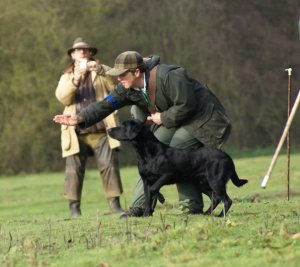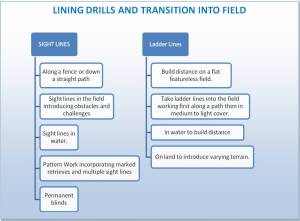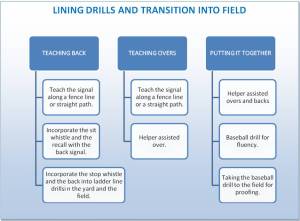Everyone who has ever trained a gundog to work on blind/unseen retrieves has done this drill at one time or another. The “primary” role of the basic pile retrieve exercise is to teach confidence for the send away and part of the introduction to sight blinds. One of the principal aims is to teach the quick pick-up and prompt return. But, in addition, it also assists in the hold-heel-sit-deliver sequence becoming very automatic in the dog while he is concentrating on being sent for another retrieve. In the field the dog has to remember how to swing into heel position and sit down focussed on the field (not up at your face) while holding onto the one he’s carrying and then delivering it properly. He has to do all this while he is excited about watching the next throw, or going for the next bird of a multiple mark. Having a pile of objects in front of him that he knows he will be sent to again provide the forward focus and of course keeps the subsequent retrieve aspect in the mix while he practices all the sub skills.
One disadvantage of pile work is that most dogs will try to shop, at least a little so the pile retrieve exercise can be considered a form of proofing to NOT do it. Shopping is likely to appear in a minor or major way with more than half the retrievers out there.
Troubleshooting the Shopping Habit
Some dogs just love to test each dummy in the pile before selecting the one that is “just right” and then returning to the handler. There are some things you could do to stop shopping:
- Make sure that the recall component of the retrieve is much more fun than shopping. A solid, reliable recall is the best way to nip this behaviour in the bud from the very beginning. A dog cannot be spinning around to answer a recall cue if he is trying to shop. It is an incompatible behaviour.
- You could also limit options with a long line so that he cannot shop once something is in his mouth thus taking away the opportunity to self-reward with this undesirable behaviour.
- What would also work is following him to the pile so that you are close to him when he picks up which would make you the biggest thing in his world right then, not the next dummy. Then gradually lengthen the following distance.
With a beginner dog that is only just learning the lining exercise you will probably get a couple of attempted shops and if you do not allow the shopping to become a habit by following the options outlined above the shopping will be over so quickly you will wonder if you really “trained” the dog not to do it. But you did. Dogs do what works. If shopping does not work for him the first time he tries it, compared to alternatives that work better (give him more pleasure), he is not likely to continue to do it.
Another way to increase the no-shopping proofing once your dog has the basic understanding is to use a pile of non-similar objects. For example, large and small dummies, some canvas, some plastic, and a Dokken duck (if familiar to the dog). Do not expect the dog to grab the closest object, and it is okay for him to inspect the pile (quickly) for his preferred object. But whichever one he picks up first needs to stay in his mouth and be delivered, even if he wishes he’d grabbed a different one. He will get an opportunity to do that on the next send!
Louise’s Comment: These insights come as a result of a discussion on the Positive Gundogs forum. http://groups.yahoo.com/neo/groups/PositiveGunDogs/info




 Posted by clickapup
Posted by clickapup 




